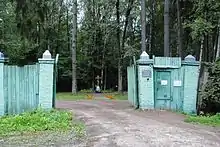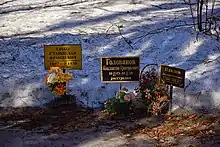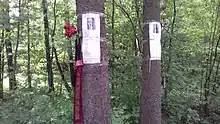


The Kommunarka firing range (Russian: Расстрельный полигон «Коммунарка»), former dacha of secret police chief Genrikh Yagoda, was used as a burial ground from 1937 to 1941. Executions may have been carried out there by the NKVD during the Great Terror and until the war started; alternatively, bodies of those shot elsewhere might have been brought there for later interment.[1] As Russian historian Arseny Roginsky explained: "firing range" was a popular euphemism adopted to describe mysterious and closely-guarded plots of land that the NKVD began to set aside for mass burials on the eve of the Great Terror.[2]
Identifying the victims
Talking to Izvestiya in 2007 a representative of the Federal Security Service suggested that approximately 10,000 people had been killed and buried in mass graves at Kommunarka.[3] Painstaking work by Memorial researchers and others in the 1990s established the identity of 4,527 known to be buried there. Their names were published in Memorial's first Book of Remembrance.[4] Before Kommunarka opened as a memorial complex in 2018 an archaeological survey indicated that 6,600 bodies probably lay there, the total number of names since reached through further documentary research.[1]
As with so many other "firing ranges" throughout the former Soviet Union, the FSB (successor to the KGB and the NKVD) retained control of the territory for many decades thereafter. Only in 1999, was the land transferred, as with the Butovo firing range south of Moscow, to the Russian Orthodox Church. Only on 14 November 1999 did a plaque commemorating the Victims of Political Repression at the "special installation" finally appear, later than at any other mass burial site in Moscow, comments Arseny Roginsky.[2] A church dedicated to Russia's New Martyrs and Confessors, i.e. those who had died for their Christian faith during the Soviet period, was built at Kommunarka and their feast day was thereafter celebrated each year on or around 25 January.
Opening and controversy
On 27 October 2018 when the memorial site opened all 6,609 names of those known to be buried there were included on the Wall of Remembrance. A controversy then arose over the inclusion on the lists of some 50 high-ranking secret police officers (including Yagoda himself) none of whom had been rehabilitated.[5]
The decision to use a single list was explained by Memorial (society) chairman Jan Raczynski, one of those who had taken part in discussions of the form the memorial complex should take: other partners in the project were the Gulag Museum, representatives of the buried victims, the Moscow city commission for the Victims of Political Repression and the Russian Orthodox Church. The committee concluded, said Raczynski, that everyone deserved a grave to which relatives and descendants might come. This included all those who had been buried at Kommunarka but in no sense did it exonerate them of any earlier crimes.[6]
Notable victims
- Yakov Agranov
- Tobias Akselrod
- Yakov Alksnis
- Anandyn Amar
- Vasily Anisimoff
- Nikolay Antipov
- Vladimir Antonov-Ovseyenko
- Juris Aploks
- Ernest Appoga
- Artur Artuzov
- Ölziin Badrakh
- Žanis Bahs
- Mikhail Batorsky
- Alexander Bekzadyan
- Abram Belenky
- Alexander Beloborodov
- Boris Berman
- Matvei Berman
- Eduard Berzin
- Reingold Berzin
- Yan Karlovich Berzin[2]
- Anastasia Bitsenko
- Waclaw Bogucki
- Mykhailo Bondarenko
- Mieczysław Broński
- Pyotr Bryanskikh
- Andrei Bubnov
- Nikolai Bukharin[7]
- Pavel Bulanov
- Dadash Bunyadzade
- Hayk Bzhishkyan
- Hugo Celmiņš
- Mikhail Chernov
- Sergey Chernykh
- Jūlijs Daniševskis
- Yakov Davydov
- Terenty Deribas
- Dansranbilegiin Dogsom
- Pavel Dybenko
- Robert Eikhe
- Ivan Fedko
- Peter Maximovich Feldman
- Filip Filipović
- Rashid Khan Gaplanov
- Ilya Garkavyi
- Aleksei Gastev
- Anatoliy Gekker
- Nikolai Gikalo
- Vladimir Gittis
- Vasily Glagolev
- Konstantin Grigorovich
- Edvard Gylling
- Hryhoriy Hrynko
- Akmal Ikramov
- Chingiz Ildyrym
- Uraz Isayev
- Vladimir Ivanov
- Bruno Jasieński
- Semyon Kamenev
- Grigory Kaminsky
- Georgii Karpechenko
- Innokenty Khalepsky
- Fayzulla Khodzhayev
- Vasiliy Khripin
- Grigory Kireyev
- Vladimir Kirshon
- Vladimir Klimovskikh
- Nikolai Klestov
- Vilhelm Knorin
- Lazar Kogan
- Nikolai Kondratiev
- August Kork
- Ivan Kosogov
- Yepifan Kovtyukh
- Nikolay Krestinsky
- Nikolai Krylenko
- Pyotr Kryuchkov
- Béla Kun
- Vladimir Lazarevich
- Eduard Lepin
- Izrail Leplevsky
- Mikhail Levandovsky
- Lev Levin
- Ivan Lorents
- Darizavyn Losol[8]
- Dorjjavyn Luvsansharav
- Maksim Mager
- Theodore Maly
- Mykola Marchak
- Joseph Meerzon
- Shmarya Medalia
- Stanislav Messing
- Romuald Muklevich
- Georgii Nadson
- Jamshid Nakhchivanski
- Stepan Oborin
- Valerian Osinsky
- Eduard Pantserzhanskiy
- Karl Pauker
- Dmitry Pavlov
- Jēkabs Peterss
- Osip Piatnitsky
- Boris Pilnyak
- Yevgeny Polivanov
- Yakov Popok
- Bronislava Poskrebysheva
- Nikolay Rattel
- Arkady Rosengolts
- Kustaa Rovio
- Jānis Rudzutaks
- Alexei Rykov
- Turar Ryskulov
- Andrei Sazontov
- Vasily Schmidt
- Alexander Sedyakin
- Alexander Serebrovsky
- Suren Shadunts
- Vasily Sharangovich
- Zolbingiin Shijee
- Boris Shumyatsky
- Jan Spielrein
- Sergey Spigelglas
- Mikhail Svetšnikov
- Pavel Sytin
- Alexander Svechin
- Branislaw Tarashkyevich
- Alexander Tarasov-Rodionov
- Mikhail Trilisser
- Jozef Unszlicht
- Maksim Unt
- Semyon Uritsky
- Aleksandr Uspensky
- Leonid Ustrugov
- Jukums Vācietis
- Yakov Yakovlev
- Yefim Yevdokimov
- Konstantin Yurenev
- Leonid Zakovsky
- Isaak Zelensky
- Nikolai Zhilyayev
- Prokopy Zubarev
An elite burial ground
Leading Bolsheviks convicted at the two later Moscow Show Trials were among the many prominent Party leaders buried at Kommunarka, particularly those publicly tried convicted at the so-called Case of the Anti-Soviet "Bloc of Rightists and Trotskyites" in March 1938. (Some defendants from the second Show Trial in January 1937 like Beloborodov and Bubnov who were charged but did not appear in court were also buried at Kommunarka.)[9]
Yagoda has already been mentioned. Most of the other defendants in the March 1938 Trial of the Twenty One are listed above: Bukharin, Rykov, Krestinsky, Rosengolts, Vladimir Ivanov, Mikhail Chernov, and Isaak Zelensky; Uzbek leaders Akmal Ikramov and Faizulla Khodjaev; Vasily Sharangovich, Prokopy Zubarev, and NKVD officer Pavel Bulanov; Kremlin doctors Lev Levin and Ignaty Kazakov; Venyamin Maximov-Dikovsky and Pyotr Kryuchkov, Maxim Gorky's secretary. (Missing from the list are Rakovsky, Bessonov and Pletnyov who were given heavy terms of imprisonment in 1938. Later they were summarily executed in 1941 during the first months of the war.)
Among the Mongolian revolutionaries (Badrakh, Dogsom, Losol, Luvsanshara and Shijee), the writers (Pilnyak, Kirshon, Jasienski), Red Army and NKVD officers (Agranov, the Berman brothers, Berzin, Kogan, Pauker) there were also two Central Europeans. Bela Kun headed the short-lived 1919 Soviet republic in Hungary; ex-priest Theodore Maly recruited Soviet agents abroad and in the mid-1930s was for a while handler of the Cambridge Five spy-ring.[10]
See also
- Butovo memorial complex, near Moscow
- Mass graves in the Soviet Union
- Memorial (society)
- Moscow Show Trials
- Sandarmokh memorial complex (Karelia)
References
- 1 2 "The Kommunarka burial site in Moscow", Russia's Necropolis of Terror and the Gulag Archived 21 November 2021 at the Wayback Machine. en.mapofmemory.org
- 1 2 3 Arseny Roginsky, "Epilogue", Those shot at Kommunarka, Memorial: Moscow, 2000 Archived 28 September 2013 at the Wayback Machine (in Russian).
- ↑ "The 'Monastery' special installation", Izvestiya, 2007 Archived 23 February 2017 at the Wayback Machine (in Russian).
- ↑ Execution lists, Moscow 1937–1941: Kommunarka and Butovo, Memorial: Moscow, 2000, 502 pp. (in Russian).
- ↑ "Tortured past: victims and perpetrators side by side", RFE/Radio Liberty, 27 December 2018 Archived 21 November 2021 at the Wayback Machine.
- ↑ "Kommunarka 2018", The Dmitriev Affair website Archived 21 November 2021 at the Wayback Machine.
- ↑ Shot and Imprisoned Members of the USSR Academy of Sciences Archived 24 September 2015 at the Wayback Machine(in Russian).
- ↑ Mongolian Ministry of Foreign Affairs Archived 30 March 2023 at the Wayback Machine (in Mongolian).
- ↑ Robert Conquest, The Great Terror: A reassessment, 1990, hbk, pp. 122 and 240.
- ↑ Andrew, Christopher (2009). The Defence of the Realm: The Authorized History of MI5. Alfred A. Knopf. pp. 180–181. ISBN 978-0307263636.
External links
 Media related to Poligon Kommunarka at Wikimedia Commons
Media related to Poligon Kommunarka at Wikimedia Commons- List of those buried at Kommunarka, Memorial, 2000 (in Russian).
- Russia's Necropolis of Terror and the Gulag: A select directory of burial grounds and commemorative sites